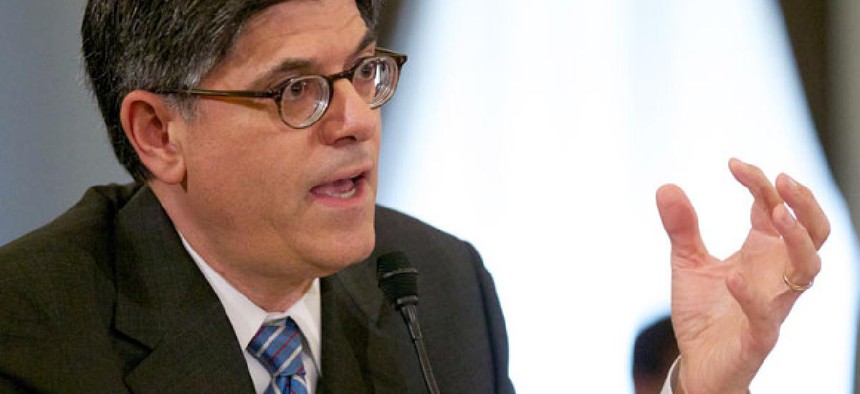
Treasury Secretary Jack Lew Molly Riley/AP
Treasury Taps Federal Retirement Coffers Again
‘Extraordinary’ debt ceiling measure has become more ordinary in recent years.
The Treasury Department once again is tapping federal retirement programs to buy the government more time to increase the nation’s debt ceiling.
Treasury Secretary Jack Lew on Friday announced the extraordinary measures the government will use to avoid a default through the summer, including tapping into and suspending investments into the Civil Service Retirement and Disability Fund and halting the daily reinvestment of the government securities (G) fund, the most stable offering in the Thrift Savings Plan's portfolio.
Lew could not provide a specific timeframe for the debt issuance suspension period. “The effective duration of the extraordinary measures is subject to considerable uncertainty due to a variety of factors, including the unpredictability of tax receipts, changes in expenditure flows under the sequester, and the normal challenges of forecasting the payments and receipts of the U.S. government months in the future,” Lew wrote in a May 17 letter to House Speaker John Boehner, R-Ohio, and other congressional leaders.
The G Fund is invested in interest-bearing Treasury securities -- bonds -- that make up the public debt. The Civil Service Retirement Fund finances benefit payments under the Civil Service Retirement System and the basic retirement annuity of the Federal Employees' Retirement System, and those investments are made up of securities also considered part of the public debt.
Federal law requires the Treasury secretary to refill the coffers of the G Fund and the CSRDF once the issue of the debt ceiling is resolved and to make up, in addition, for any interest lost on those investments during the suspension.
Because of this, employees and retirees are not affected.
The last time Treasury tapped feds’ pensions was on Dec. 31, 2012, as the government hit its debt ceiling of $16.4 trillion. The government made whole the retirement coffers and reinvested $28 billion back into the G Fund in late February.
President Obama enacted legislation in early February authorizing a temporary suspension of the current $16.4 trillion debt limit through May 18, allowing the government to continue borrowing to pay its bills until then. After that date, the debt limit was somewhere between $16.6 and $16.7 trillion; Treasury can implement extraordinary measures for a few months to avoid a default, which the Bipartisan Policy Center estimates would happen by mid-October unless Congress approves a new debt ceiling increase above the amount accumulated through May 18.
Lew estimated that the temporary measures, which could give Uncle Sam about $260 billion in headroom under the current limit, would carry the government until after Labor Day. “Nevertheless, Congress should act sooner rather than later to protect America’s good credit and avoid the potentially catastrophic consequences of failing to act until it is too late,” he wrote. Treasury expects to receive a payment of about $60 billion from mortgage financier Fannie Mae on June 28 which will give the government some additional breathing room.
The House earlier this month passed legislation that would allow Treasury to borrow money above the debt limit only to make payments on the debt and Social Security if the government hits its ceiling. The Full Faith and Credit Act (H.R. 807) would require the government to pay the principal and interest on public debt and the Social Security trust funds before paying its other bills if it hits the limit. The government only could borrow money above the debt limit for those payments. Under the bill, payments to the debt and Social Security trust funds would take priority over troops’ pay, veterans’ benefits, contractors and Medicare, for example.
Lew’s May 17 letter reiterates Obama’s veto threat if H.R. 807 reaches him. “This legislation is unwise, unworkable, unacceptably risky, and would harm the full faith and credit of the nation,” he wrote.
NEXT STORY: More Feds Invest in Lifecycle Retirement Funds







